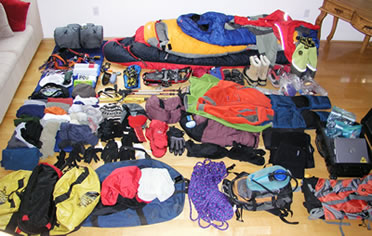EVEREST GEAR
1. Sleeping bags-- for use at different camps. One is rated to 15°F (for Base Camp), one is rated -20°F (for Camps I and II), and the third is rated to -40°F (for Camps III and IV) (for the "cold" nights!).
2. Sleeping pads--one inflatable, one foam. For insulating against heat loss while sleeping on a glacier.
3. Communications gear--laptop computer, solar panels, satellite phone, antennae, cables, batteries and spare parts in waterproof, shock resistant container (carried by yak train to base camp).
4. Backpack--medium sized (40 liters) for climbing days.
5. Daypack-- light (20 liters) for trek to Base Camp (yaks carry the rest)
| 3 sleeping bags rated --10, -20, and -40 degrees |
6. Gloves--At times we wore 4 layers, including overmitts.
7. Boots and footgear--one pair each for trekking, climbing and a comfortable pair for time spent in base camp. Also a pair of sandals.
8. Clothing layers--Base layer is capilene, next layer is fleece/pile. Multiple pairs of light, medium and heavy weight
9. Expedition parka--800 fill down, rated to -40 degrees. |

